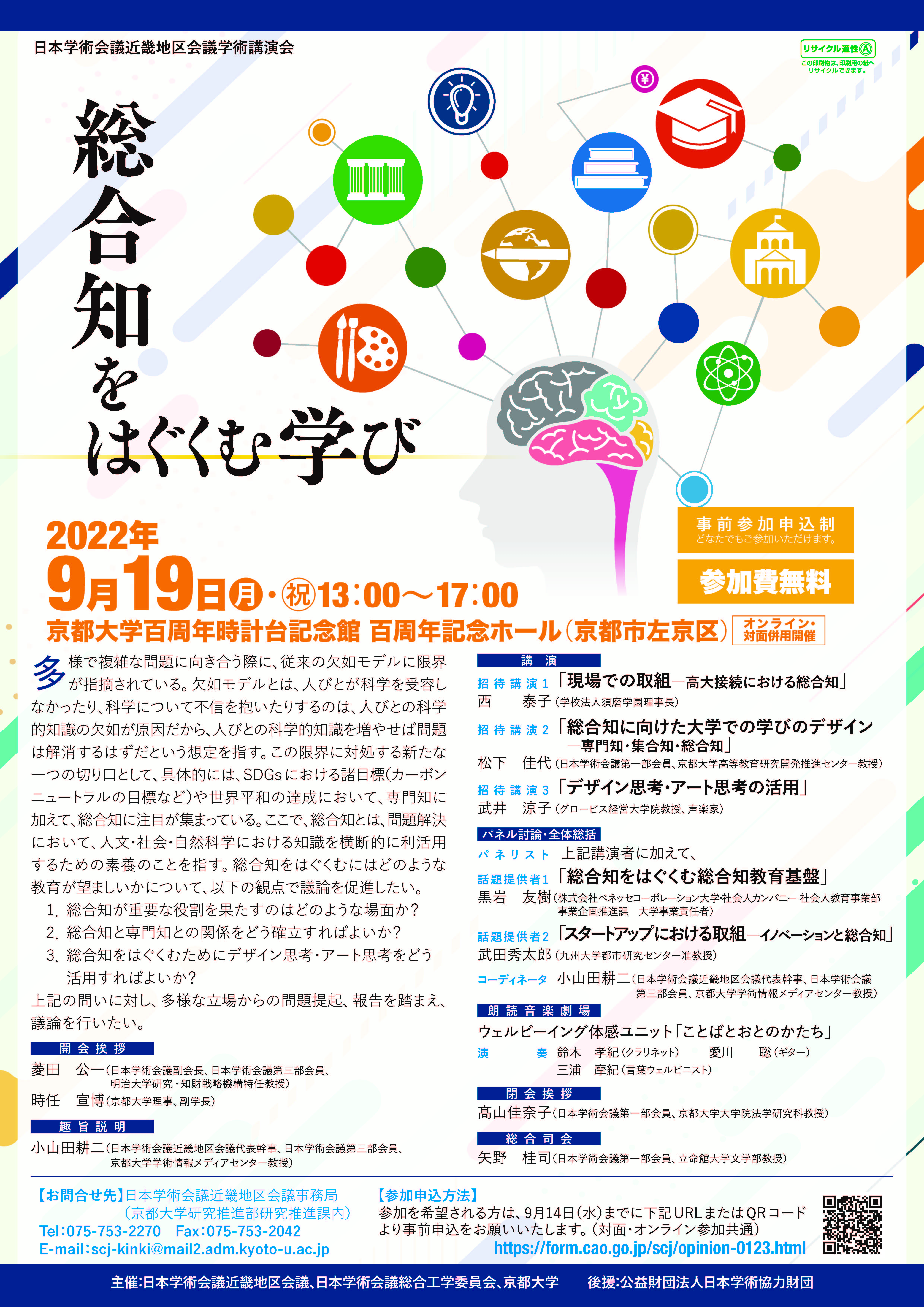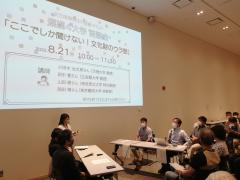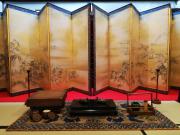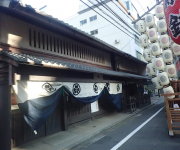-
 11
12
13
14
15
16
17
18
19
20
21
11
12
13
14
15
16
17
18
19
20
21

The ARC Days were held on Sep 16 (Fri) & 17 (Sat), 2022. It is an annual event where the faculty members of the Art Research Center, Ritsumeikan University, and international collaborative researchers whose projects have been adopted by the International Joint Digital Archiving Center for Japanese Art and Culture (ARC-iJAC) introduce their research projects in Digital Humanities (DH) in individual presentations.
To prevent the spread of COVID-19, this event was held online via Zoom and broadcasted live on YouTube.
Organizer: International Joint Digital Archiving Center for Japanese Art and Culture (ARC-iJAC), Art Research Center, Ritsumeikan University and Program for Supporting Research Center Formation, Ritsumeikan University
Read more>>[イベント情報]September 19, 2022(Mon)The Science Council of Japan Kinki District Conference Lecture on 'Learning that fosters Comprehensive Knowledge' will be held under the general chairmanship of Professor Keiji Yano (Faculty of Letters), Deputy Director of the Art Research Center (ARC), Ritsumeikan University.
Date: September 19 (Mon), 2022, 13:00-17:00 JST
Venue: Kyoto University Clock Tower Centennial Hall , Sakyo-ku, Kyoto (online and face-to-face)Anyone is welcome to participate (advance registration required).
Registration deadline: September 14 (Wed), 2022
For the registration and details, please refer to 日本学術会議近畿地区会議学術講演会「総合知をはぐくむ学び」.
Day 1: September 16, 2022 (Friday) 15:30-18:40 (JST/ tentative)
Day 2: September 17, 2022 (Saturday) 10:30-18:15 (JST/ tentative)Venue: Online (ZOOM,YouTube)
ARC members will be informed of the ZOOM URL via e-mail.
*Non-ARC members can participate via YouTube via the following link.For inquiries, please contact the Office of the Art Research Center: arc-jimu@arc.ritsumei.ac.jp
Organizer: International Joint Digital Archiving Center for Japanese Art and Culture (ARC-iJAC), Art Research Center, Ritsumeikan University and Program for Supporting Research Center Formation, Ritsumeikan University
Read more>>On September 6, 2022, the Mainichi Shimbun featured an article on the Kyoto News Archive, a digital archiving project led by Professor Keiji Yano (College of Letters, Ritsumeikan University), Deputy Director of the Art Research Center (ARC).
In collaboration with the Toy Film Museum in Kyoto, Prof. Yano and his team have been building a digital archive of Kyoto News--a series of newsreels produced by Kyoto City between 1956 and 1994 (Showa 31 - Heisei 6).
During that period, the newsreels were shown in movie theaters in Kyoto before the start of the main film. As one of the earliest regional newsreels, they are a valuable historical testimony of Kyoto City. They have recorded a wide range of topics in the city, including seasonal customs and festivals.
[イベント情報]August 26, 2022(Fri)Based on the research cooperation agreement of the Art Research Center (ARC), Ritsumeikan University, with Nara Prefecture, a digital archiving project on Taimadera Temple in Katsuragi, Nara, has been conducted by the ARC faculty member Prof. Tanaka (College of Information Science and Engineering, RU) and his team for the purpose of preserving cultural heritages.
On August 21, 2022, Prof. Tanaka presented the research outcomes of his project on the ultra-high-quality see-through 3D visualization of Taimadera Temple--a national treasure-- at a roundtable event at the Nara Prefecture Historical and Artistic Culture Complex, which was held as part of the special exhibition 'Researching Cultural Heritages' (「文化財研究中!―なら歴史芸術文化村×連携4大学―」). 3D measurements of the entire temple precincts, mainly the Kondou Hall and the West Pagoda, have been taken, with the number of laser-scanned point cloud data exceeding several billion points.
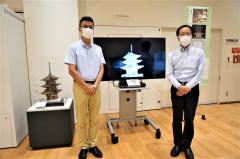
Furthermore, Prof. Tanaka introduced the ARC-iJAC international joint research project on the digital archiving of the Borobudur Temple Compounds in Indonesia--a UNESCO World Heritage Site--to the audience. This project has been conducted in cooperation with the Research Center for Area Studies, National Research and Innovation Agency (PRW-BRIN), Indonesia (previously: Research Center for Area Studies, Indonesian Institute of Sciences (P2W-LIPI)).
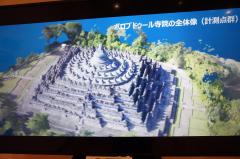
The research outcomes of the ARC, as well as those of three other universities researching various cultural heritages in Nara, are showcased as part of the special exhibition held at the Nara Prefecture Historical and Artistic Culture Complex between July 23 and September 19, 2022.
Related article: An Interview with Prof. Satoshi Tanaka (College of Information Science and Engineering) on Visualizing Large-Scale Cultural Heritage
Related event: Special Exhibition 'Researching Cultural Heritages' at the Nara Prefecture Historical and Artistic Culture Complex
Read more>>[イベント情報]August 25, 2022(Thu)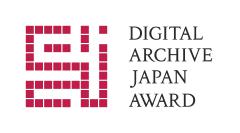 On August 25, 2022, the Art Research Center (ARC), Ritsumeikan University, received the Digital Archive Japan Award (DAJ).
On August 25, 2022, the Art Research Center (ARC), Ritsumeikan University, received the Digital Archive Japan Award (DAJ).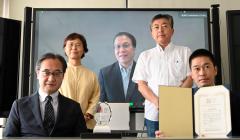 The Digital Archive Japan Award (DAJ) is an award system newly established by Japan Search, an online platform operated by the National Diet Library, Japan, for aggregating metadata of digital resources of various fields, including book/publication, official documents, and art.
The Digital Archive Japan Award (DAJ) is an award system newly established by Japan Search, an online platform operated by the National Diet Library, Japan, for aggregating metadata of digital resources of various fields, including book/publication, official documents, and art.The DAJ Award has been designed to widely introduce to society the initiatives that integrate digital archives into daily life, such as the promotion of digitization, open contents, and the provision of new services using digital technology to create momentum for their utilization. The ARC is honored to be one of the first recipients of this award.
The award ceremony was held at the Digital Archive Fest 2022 (「デジタルアーカイブフェス2022」)--hosted by the National Diet Library and the Cabinet Office--where industry, academia, and government officials gathered to discuss cutting-edge case studies and commended good practices for promoting digital archiving in Japan.
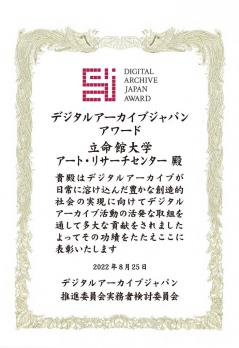
The ARC received this award for its role as an international link for Japanese art and culture by publishing online databases--including ukiyo-e, early Japanese books, and banzuke-related contents--while collaborating with various domestic and international institutions and individuals to enhance the discoverability of such contents and presenting a model in this field of the art and culture. Furthermore, the ARC was recognized for its efforts in developing metadata and providing access to pages that contain terms and conditions of use for each institution.
In his acceptance speech, Professor Ryo Akama, Director of the Art Research Center (ARC), expressed that, for a quarter of a century since its establishment in 1998, the center has been taking digital archives as the foundation for its research activities. On the day, Associate Professor Takaaki Kaneko delivered the award acceptance speech in Prof. Akama's place.
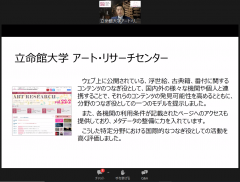
He highlighted that the center has been accumulating a vast amount of contents while mainly targeting overseas museums. "The excellent mechanisms of Japan Search have allowed us to clearly position ourselves as an international link," said Professor Akama.
He expressed his intention to take the Digital Archive Japan Award (DAJ) to provide information on domestic cultural resources and areas other than ukiyo-e, early Japanese books, and banzuke-related contents to further respond to the needs of users worldwide.
Related links:
Japan Search: https://jpsearch.go.jp/
・shiRUto「文系学問の未来を担う「デジタル人文学」(前編) 知られざる価値を見出す仕事」https://shiruto.jp/culture/1799/
・【大学院生の挑戦】空白の江戸中期・天明歌舞伎の実態を解明する~デジタルアーカイブを駆使し、全世界に散らばった浮世絵を統合的に分析~ http://www.ritsumei.ac.jp/news/detail/?id=2694
[イベント情報]August 8, 2022(Mon)On August 8, 2022, the Tokyo Shimbun featured an article on the release of the pre-war programs of the Kabuki-za Theatre in the Shochiku Otani Library's Shibai Banzuke Browsing System (松竹大谷図書館所蔵・芝居番付検索閲覧システム).
As part of the FY 2022 ARC-iJAC project of the Shochiku Otani Library and based on an agreement between the library and the Art Research Center (ARC), the digitized programs have been integrated into the Shochiku Otani Library's Shibai Banzuke Browsing System (松竹大谷図書館所蔵・芝居番付検索閲覧システム), developed and made available to the public by the ARC.
Shochiku Otani Library <Shibai Banzuke Browsing System>
< https://www.dh-jac.net/db1/ban/search_shochiku.php?enter=shochiku&lang=en > With the establishment of the International Joint Digital Archiving Center for Japanese Art and Culture (ARC-iJAC) in 2019, the Art Research Center strives to push the internationalization of research activities that transcend disciplines and geographic boundaries.
With the establishment of the International Joint Digital Archiving Center for Japanese Art and Culture (ARC-iJAC) in 2019, the Art Research Center strives to push the internationalization of research activities that transcend disciplines and geographic boundaries.NEWS
Important Notice:
The ARC will be closed from Aug 11 to Aug 17 due to the Obon holiday break. Please note that we will not be able to respond to your inquiries or visits during this period. Thank you for your kind understanding in advance.
 Recently, we welcomed Prof. Monte Cassim, the President of Akita International University (AIU), and Prof. Akitoshi Seiyama, the Director of AIU's Creative Design & Data Science Center, to the ARC.
Recently, we welcomed Prof. Monte Cassim, the President of Akita International University (AIU), and Prof. Akitoshi Seiyama, the Director of AIU's Creative Design & Data Science Center, to the ARC.
Furthermore, we were delighted to meet Ms. Pei Liu, Senior Partnerships Manager at Nottingham Trent University, UK.We created this video for the Comprehensive Digitization and Discoverability Program (CDDP) of the North American Coordinating Council on Japanese Library Resources (NCC).
Are you interested in using our Kuzushiji Transcription Support and Archiving System for your research or classes?
Please contact us! Prof. Hans B. Thomsen, the Chair for East Asian Art History at the University of Zurich, Switzerland, has been conducting two ARC-iJAC projects under the theme of 'Tracing the Reception of Japanese Art in the West' by investigating the collections of Freiburg im Breisgau and Monte Verità. >> Read the interview.
Prof. Hans B. Thomsen, the Chair for East Asian Art History at the University of Zurich, Switzerland, has been conducting two ARC-iJAC projects under the theme of 'Tracing the Reception of Japanese Art in the West' by investigating the collections of Freiburg im Breisgau and Monte Verità. >> Read the interview.
Pre-war Programs (sujigaki) of the Kabuki-za Theater, Tokyo, have been released in the Shochiku Otani Library's Shibai Banzuke Browsing System 
The Shibai Banzuke Portal Database, developed and made available by the ARC, allows users to simultaneously search the ARC's banzuke collection and that of the Shochiku Otani Library and other institutions. 
Along with the release of the digitized pre-war theater programs (筋書; sujigaki) of the Kabuki-za (歌舞伎座) held by the Shochiku Otani Library, the pre-war sujigaki of the Imperial Theater (帝国劇場) held by the ARC are also available. >> Read more. Explore 'The Kyoto News Archive' in the ARC Virtual Institute  In collaboration with the Toy Film Museum Kyoto, the ARC has built a digital archive of Kyoto News, newsreels produced by Kyoto City and shown in movie theatres between 1956 and 1994.
In collaboration with the Toy Film Museum Kyoto, the ARC has built a digital archive of Kyoto News, newsreels produced by Kyoto City and shown in movie theatres between 1956 and 1994.< ARC Virtual Institute: The Kyoto News Archive >  As one of the earliest regional newsreels, it represents a valuable historical testimony of Kyoto. On July 2, the public symposium 'The Kyoto News Archive' was held to commemorate the launching of the archive.
As one of the earliest regional newsreels, it represents a valuable historical testimony of Kyoto. On July 2, the public symposium 'The Kyoto News Archive' was held to commemorate the launching of the archive.
>> Read more.
>> Watch the full video.Special Exhibition at the Nara Prefecture Historical and Artistic Culture Complex Showcases Research Outcomes of the ARC from July 23 to Sep 19  Based on a research cooperation agreement with Nara Prefecture, the project outcomes on the digital archiving and 3D visualization of Taimadera Temple in Nara, led by Prof. Satoshi Tanaka (College of Information Science and Engineering, RU), are showcased at the Nara Prefecture Historical and Artistic Culture Complex.
Based on a research cooperation agreement with Nara Prefecture, the project outcomes on the digital archiving and 3D visualization of Taimadera Temple in Nara, led by Prof. Satoshi Tanaka (College of Information Science and Engineering, RU), are showcased at the Nara Prefecture Historical and Artistic Culture Complex.
Free entry! >> Read more.The Byobu Matsuri (Folding Screen Festival) was held at the Nagae Family Residence 
The Byobu Matsuri, or Folding Screen Festival, was held at the Nagae Family Residence--designated by Kyoto City as a tangible cultural property--from July 14 to July 16, 2022. The ARC has been digital-archiving the collection of the Nagae Family after it was donated to Ritsumeikan University. >> Read more. Upcoming Events
July 23 (Sat) - Sep 19 (Mon)
Special Exhibition 'Researching Cultural Heritages'
Location: Nara Prefecture Historical and Artistic Culture Complex
>> Details
>> Official website of the Nara Prefecture Historical and Artistic Culture ComplexSAVE THE DATE!September 16 & 17 (Sat/ Sun)ARC Days 2022
Details will be announced on the ARC website shortly.


Previous issues:
Spring 2022, Winter 2021, Autumn 2021, Summer 2021, Spring 2021, Winter 2020, Autumn 2020, Summer 2020, Spring 2020view this email in your browser Copyright © 2021 Art Research Center, Ritsumeikan University. All rights reserved.
Our mailing address is:
56-1 Toji-in Kitamachi, Kita-ku, Kyoto 603-8577 JAPAN
Want to change how you receive these emails?
You can update your preferences or unsubscribe from this list.[イベント情報]July 23, 2022(Sat)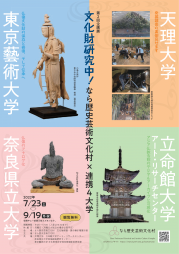 Based on a research cooperation agreement with Nara Prefecture, the project on the digital archiving and 3D visualization of Taimadera Temple in Nara--a national treasure--has been conducted by the ARC faculty member Prof. Satoshi Tanaka (College of Information Science and Engineering, RU) and his team.
Based on a research cooperation agreement with Nara Prefecture, the project on the digital archiving and 3D visualization of Taimadera Temple in Nara--a national treasure--has been conducted by the ARC faculty member Prof. Satoshi Tanaka (College of Information Science and Engineering, RU) and his team.Their research results, along with those of three other universities, will be showcased as part of the special exhibition 'Researching Cultural Heritages' at the Nara Prefecture Historical and Artistic Culture Complex between July 23 and September 19, 2022.
Special exhibition ''Researching Cultural Heritages--Cooperation of Nara Prefecture Historical and Artistic Culture Complex with 4 Universities'
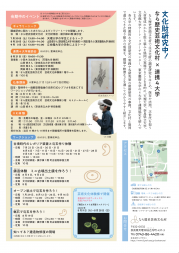
Date: July 23 (Sat) - September 19 (Mon), 2022
Time: 9 am - 5 pm (entry until 4.30 pm)
Location: Nara Prefecture Historical and Artistic Culture Complex, Exhibition Room (B1 floor)
Entrance fee: Free entry
Organizer: Nara Prefecture Historical and Artistic Culture Complex
Co-organizers: Tenri University; Art Research Center (ARC), Ritsumeikan University; Nara Prefectural University; Tokyo University of the Arts
>> See official website of the Nara Prefecture Historical and Artistic Culture Complex for details.
[イベント情報]July 21, 2022(Thu)The Art Research Center (ARC) and Hoosiers Corporation held the Byobu Matsuri, or Folding Screen Festival--a traditional event related to the Gion Matsuri--at the Nagae Family Residence in Kyoto from July 14-16, 2022.
 The Nagae Family Residence is a tangible cultural property designated by Kyoto City. Under the theme of 'Traveling,' folding screens, picture scrolls, and other artworks selected by students of the College of Letters, Ritsumeikan University, had been showcased at the residence this year.
The Nagae Family Residence is a tangible cultural property designated by Kyoto City. Under the theme of 'Traveling,' folding screens, picture scrolls, and other artworks selected by students of the College of Letters, Ritsumeikan University, had been showcased at the residence this year.Date: July 14 - 16, 2022
Venue: Nagae Family Residence, Kyoto
Time: 10:00-19:00 (last admission at 18:30)
*Note: Closed for visitors between 18:00 and 19:00 on July 15 due to a private reservation.
Reservations: Not required
Admission fee: 700 yen (to be used for preservation and repair of the house)
Related website: http://www.nagaeke.jp/
Background
The Nagae family were merchants of the kimono fabric. Their family residence, which was rebuilt and renovated after a big fire in 1864, served both as a working and living space for many generations.
The ARC has been digital-archiving the collection belonging to the Nagae Family Residence after Ritsumeikan University received it as a donation. Subsequently, the ARC has become involved in planning and managing the Byobu Matsuri held annually at the residence.
Based on an industry-academia collaboration with Hoosiers Corporation, with which Ritsumeikan University concluded a Memorandum of Understanding (MoU) in May 2015, this activity is to preserve and utilize the Nagae Family Residence for the development and promotion of education and research.
 11
12
13
14
15
16
17
18
19
20
21
11
12
13
14
15
16
17
18
19
20
21



